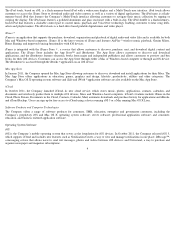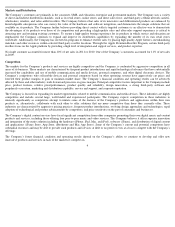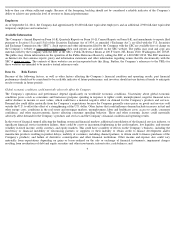Apple 2011 Annual Report Download - page 16
Download and view the complete annual report
Please find page 16 of the 2011 Apple annual report below. You can navigate through the pages in the report by either clicking on the pages listed below, or by using the keyword search tool below to find specific information within the annual report.
With respect to its Mac products, the Company believes the availability of third-
party software applications and services depends in part on the
developers’ perception and analysis of the relative benefits of developing, maintaining, and upgrading such software for the Company’
s products
compared to Windows-
based products. This analysis may be based on factors such as the perceived strength of the Company and its products,
the anticipated revenue that may be generated, continued acceptance by customers of Mac OS X, and the costs of developing such applications
and services. If the Company’s minority share of the global personal computer market causes developers to question the Company’
s prospects,
developers could be less inclined to develop or upgrade software for the Company’
s products and more inclined to devote their resources to
developing and upgrading software for the larger Windows market.
With respect to iOS devices, the Company relies on the continued availability and development of compelling and innovative software
applications, which are distributed through a single distribution channel, the App Store. The absence of multiple distribution channels, which are
available for competing platforms, may limit the availability and acceptance of third-party applications by the Company’
s customers, thereby
causing developers to reduce or curtail development for the iOS platform. In addition, iOS devices are subject to rapid technological change,
and, if third-party developers are unable to or choose not to keep up with this pace of change, third-
party applications might not successfully
operate and may result in dissatisfied customers. As with applications for the Company’
s Mac products, the availability and development of
these applications also depend on developers’ perceptions and analysis of the relative benefits of developing software for the Company’
s
products rather than its competitors’
products, including devices that use competing platforms. If developers focus their efforts on these
competing platforms, the availability and quality of applications for the Company’s devices may suffer.
The Company’s future operating performance depends on the performance of distributors, carriers and other resellers.
The Company distributes its products through wholesalers, resellers, national and regional retailers, and value-
added resellers, many of whom
distribute products from competing manufacturers. The Company also sells many of its products and third-
party products in most of its major
markets directly to education customers, cellular network carriers’
distribution channels, resellers and consumers through its online and retail
stores.
Carriers providing cellular network service for iPhone typically subsidize users’
purchase of the device. There is no assurance that such subsidies
will be continued at all or in the same amounts upon renewal of the Company’
s agreements with these carriers or in agreements the Company
enters into with new carriers.
Many resellers have narrow operating margins and have been negatively affected in the past by weak economic conditions. Some resellers have
perceived the expansion of the Company’s direct sales as conflicting with their business interests as distributors and resellers of the Company’
s
products. Such a perception could discourage resellers from investing resources in the distribution and sale of the Company’
s products or lead
them to limit or cease distribution of those products. The Company has invested and will continue to invest in programs to enhance reseller sales,
including staffing selected resellers’
stores with Company employees and contractors and improving product placement displays. These
programs could require a substantial investment while providing no assurance of return or incremental revenue. The Company’
s financial
condition and operating results could be materially adversely affected if the financial condition of these resellers weakens, if resellers stopped
distributing the Company’s products, or if uncertainty regarding demand for the Company’
s products caused resellers to reduce their ordering
and marketing of the Company’s products.
14
























